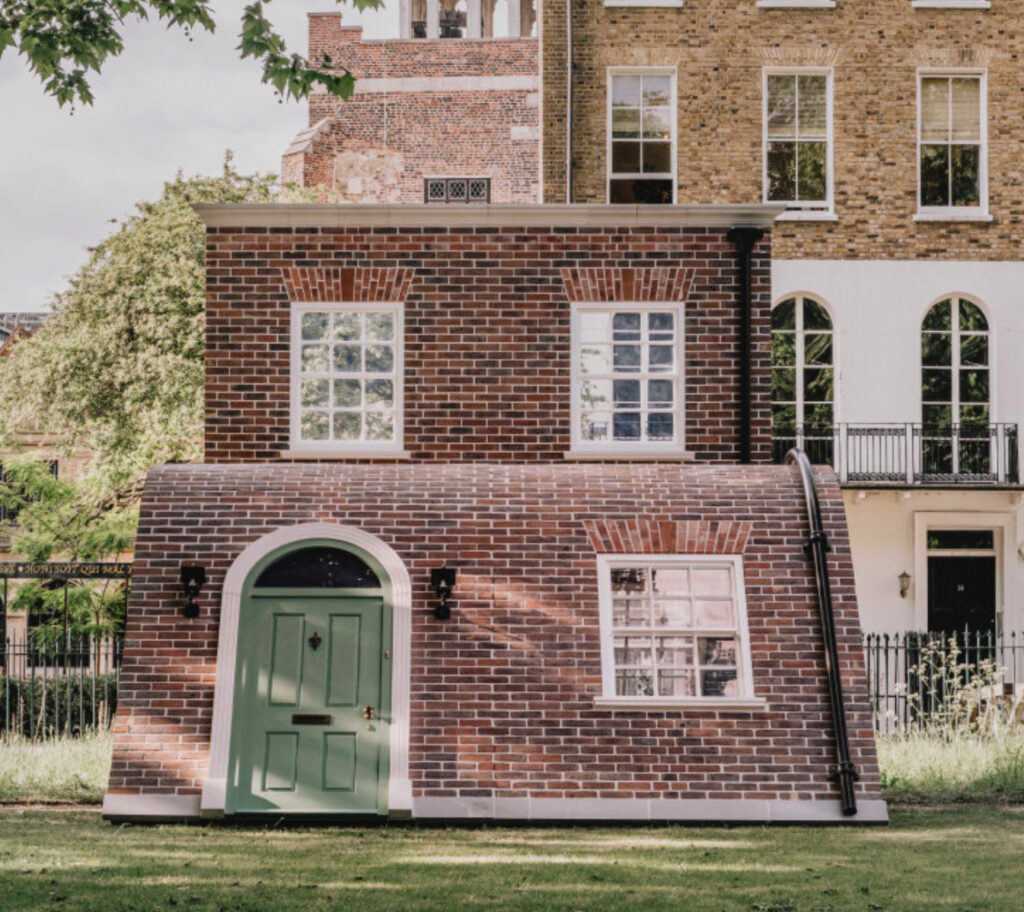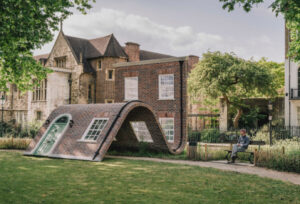At first glance, it appears to slump from exhaustion. A brick wall, bent at the knees, drooping like a figure in repose. But this is no ordinary wall—it is Alex Chinneck’s latest public artwork, unveiled at Clerkenwell Design Week 2025 and installed in London’s Charterhouse Square. Titled “A Week at the Knees,” this monumental sculpture presents a surreal spectacle of gravity, fatigue, and architectural mischief.
Known for transforming urban façades and everyday materials into sites of illusion and surprise, Chinneck’s new piece continues his ongoing dialogue with perception and material memory. 7,000 real bricks. 4.6 tons of recycled steel. Seven warped windows. One sagging door. What looks like cartoon whimsy is in fact a feat of engineering—and a meditation on the environmental and emotional weight of buildings in flux.
The artwork’s humor and audacity reflect the broader mood of Clerkenwell Design Week, where design isn’t simply about form or function, but the poetic manipulation of the built world. In Chinneck’s case, architecture doesn’t just house—it slumps, sighs, bends, and rests.
Charterhouse Square as Stage and Subject
Situated in Charterhouse Square, a site laden with history dating back to the 14th century, “A Week at the Knees” acts as both an architectural intervention and a form of performance. Rather than being cordoned off in a gallery or private collection, it sits squarely in public space, inviting everyday passersby—commuters, tourists, children—to walk beneath, lean against, and wonder.
Charterhouse Square becomes not just backdrop but collaborator. The manicured grass seems to cushion the sculpture’s imaginary descent, the gravel pathway becomes a temporary underpass, and the historical buildings surrounding it offer a stark contrast to Chinneck’s illogical brick ballet.
In this way, the site-specificity of the work is paramount. It reshapes how we inhabit public space—not by imposing upon it, but by gently kneeling into it.
The Anatomy of Collapse
Chinneck has long played with illusion, but “A Week at the Knees” marks a new level of material authenticity and environmental responsibility. While the sculpture may appear like foam or cardboard cloaked in faux brick, it is, in fact, composed of genuine construction-grade materials, meticulously manipulated to appear pliable.
- Bricks: 7,000 total, combining First Quality Multi Bricks and Floren Albion bricks. The former is known for its high structural integrity; the latter for its deep red tonal variation. Together, they produce a patina of weathered familiarity.
- Steel: 4.6 tons of reused steel salvaged from the now-demolished American Embassy in London. This gesture is not just poetic—it’s ecological. By reusing materials, Chinneck reduced the sculpture’s environmental footprint by approximately 9.3 tons of carbon emissions.
- Windows and Door: Seven windows, four with bent steel frames, and one surreal, slumped door—all fabricated in collaboration with Crittal Windows, known for their industrial heritage aesthetic. Each window appears mid-bend, as if the building were exhaling after centuries of upright posture.
This is materiality as metaphor. Nothing is fixed. Nothing stays upright forever. In Chinneck’s universe, architecture emotes.
Precision and Play
Despite the whimsical appearance, the work’s construction is a masterclass in precision fabrication. All bricks were precision cut by FabSpeed, a specialist in high-performance material shaping. Their technology allowed for the clean yet organic curves that define the “knees” of the sculpture.
To shape solid bricks into forms suggestive of fabric or cartilage, Chinneck worked alongside Michelmersh Group, whose artisan brickmaking allowed him to maintain visual continuity even while the forms bent physics. The surrealism isn’t added digitally or painted on—it is embedded structurally.
What Chinneck achieves is a hybrid of two architectural traditions: the rigid and the performative. He blurs the line between façade and theater, between architecture and narrative, between object and gesture.
The Humor of Exhaustion
There’s something irresistibly human about “A Week at the Knees.” Despite its size, it feels intimate, almost anthropomorphic. The wall doesn’t fall—it rests. It doesn’t collapse—it sits down, weary but dignified, inviting us to imagine what architectural forms feel after years of tension.
This quiet, almost slapstick humor is essential to Chinneck’s appeal. Like his past works—such as “Sliding House” or “Pick Yourself Up and Pull Yourself Together”—his new sculpture prompts not just admiration but grins, pauses, and puzzled delight. It suggests that architecture need not be solemn. It can be cheeky, tired, playful, melancholic.
For all its apparent lightness, “A Week at the Knees” gestures toward something deeper: the way our cities bear the emotional and environmental weight of their own construction. The title itself—humorous and elegiac—suggests both a temporal frame and a physical consequence. One week. On its knees.
Public Art in an Era of Impermanence
Unveiled during Clerkenwell Design Week 2025, the sculpture represents a kind of artistic manifesto: public art should be temporary, tactile, and interactive. Visitors are encouraged to walk beneath the arch, take selfies, lounge against its sloped sides. There are no barriers. No ticketing. No scheduled performances. Just a structure that exists in dialogue with the public.
This stands in stark contrast to permanent monuments or detached gallery installations. Chinneck’s piece is ephemeral, playful, and designed for disappearance. It will remain in Charterhouse Square only until early July 2025, after which it will be disassembled. But like all powerful design, its impression will outlive its physical presence.
It’s a radical proposal: that the most meaningful artworks are the ones that stay with us emotionally, not spatially.
Sustainability as Spectacle
One of the most compelling aspects of “A Week at the Knees” is its environmental intentionality. Rather than rely on new resources, Chinneck builds his illusion from the wreckage of empire—repurposing steel from the demolished American Embassy, itself a symbol of geopolitical decline and regeneration.
By doing so, he weaves a narrative where material becomes message. The same steel that once enforced diplomacy now bends under the weight of art. It’s a quiet subversion—a wall that kneels rather than guards.
Chinneck’s use of recycled bricks, steel, and window frames is not simply sustainable—it’s poetic. It invites the viewer to see beauty in reuse, character in wear, and personality in imperfection.
Ideologue
With “A Week at the Knees,” Alex Chinneck continues to masterfully operate in the liminal spaces of architecture and sculpture, of illusion and engineering. This installation is more than a crowd-pleasing photo-op or a surreal spectacle. It is a meditation on fatigue, transformation, and the emotional textures of the built world.
In a city constantly reshaped by demolition, construction, and reinvention, Chinneck’s sculpture offers a pause. A breath. A kneel. It reminds us that our cities are not only shaped by stone and steel—but by our perceptions, our interactions, and our willingness to imagine buildings that laugh, sleep, and dream.
“A Week at the Knees” stands not just as an art installation but as an invitation to rethink the rigidity of our surroundings. At once playful and profound, temporary and unforgettable, it turns architecture into allegory—and leaves us wondering what other buildings might do, if only we let them bend.
No comments yet.









